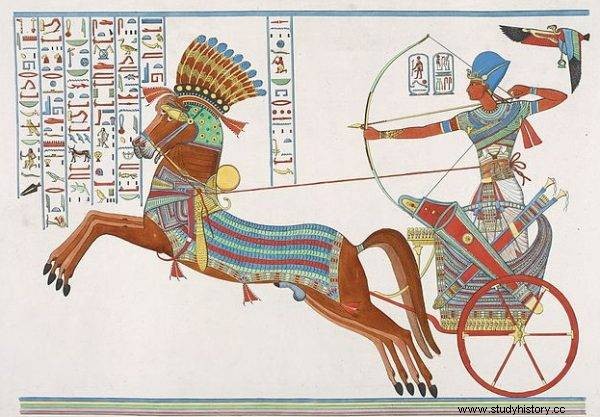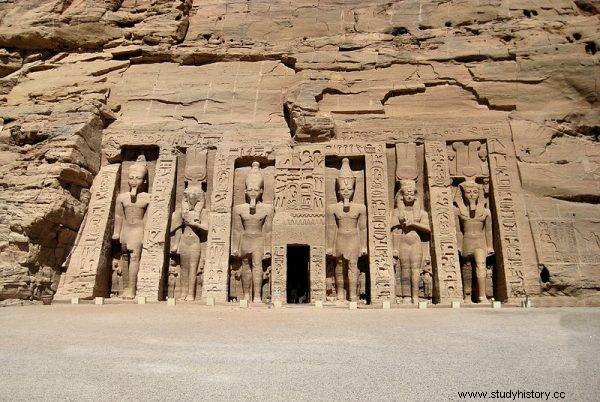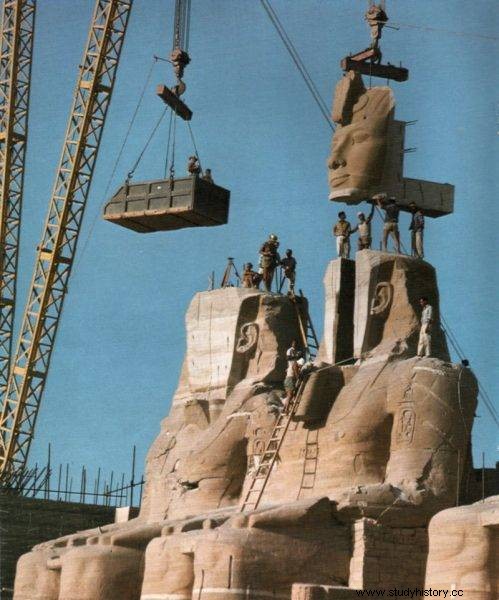He was perhaps the longest reigning and most prominent pharaoh. He created the power of Egypt. Ramses II the Great died three thousand years ago, but his fame continues today.
He had about 100 sons and over 50 daughters, was the longest-reigning pharaoh of Egypt, and by building one of the most unusual temples in the world, he secured his immortality. The power and glory of Ramses II continue to this day… in Abu Simbel.
The most powerful pharaoh
Ramses II is called the Great by historians for a reason. He is probably the longest reigning ruler of Egypt. He ruled the New Kingdom around 1200 B.C. He was the third pharaoh of the nineteenth dynasty, the son of Seti I. He sat on the throne at the age of only 25 and remained on the throne for a record (for Egyptian realities) 66 years. His subjects even then considered him immortal because he lived to the ripe old age of 91.

From the beginning of his reign, Ramses II was not idle.
From the beginning of his reign, Ramses II was not idle. Traveling around the country, he supervised numerous construction projects. He quickly changed his royal title too, adding "Setepen-Re" . In this way, on the one hand, he wanted to emphasize his special relationship with this god, and on the other - to give himself a rank equal to the deities. The following years passed for Ramses on numerous military campaigns in Syria and Libya. It is commonly believed that the period of his reign was for Egypt a time of prosperity, stabilization and, above all, comprehensive development.
Discovery and disappointment
Buried for centuries in the desert sands, the Abu Simbel Temple was not discovered until 1813. This was done by the Swiss traveler Johann Ludwig Burckhardt . He noticed the head of one of the statues protruding from the sand, and the diadems of two others. Only five years later, also known for his discoveries in the Valley of the Kings, Giovanni Battista Belzoni set off for the Nubian desert to excavate the statues and buildings. He was, however, very disappointed. As a treasure hunter, he expected to find wealth within the interior of a royal tomb. Meanwhile - except for a few statues - the temple was empty.
A temple like no other
After more than three thousand years, Abu Simbel continues to be admired not only for the power of the pharaoh, but above all for the craftsmanship of its builders. The entrance is guarded by four mighty statues of Ramses himself. Each of them is over 20 meters high - they are the tallest preserved giants in Egypt. It is worth taking a closer look at them. Next to the statues there are also smaller sculptures of the pharaoh's closest :wife, mother, sons and daughters. At his feet, there are bound prisoners - enemies of the state.
Work on the construction of the temple began in the fifth year of Ramses' reign, and was completed thirty years later. Its ancient popularity did not last long. Probably Abu Simbel was buried by the sands of the desert and forgotten shortly after the death of its founder. Neither the Greeks nor the Romans mention it.

After more than three thousand years, Abu Simbel continues to be admired
Contrary to appearances, the temple is not dedicated to Ramses, but to the sun gods Amon-Re and Re-Horachte and the god of arts and crafts, Ptach. Above the main entrance, between the heads of the colossi, there is a modest statue of the sun god Re with the head of a falcon.
Magic of light
Behind the façade there are as many as 14 rooms, carved in the rock and reaching almost 60 meters deep. The first, the largest, is the hypostyle hall with eight sizable statues of Ramses at the pillars. Behind it and on the sides there are smaller rooms. At the end is the sanctuary where the pharaoh ordered to introduce himself to the gods. The decorations on the walls are in excellent condition. They mainly show the military achievements of Ramses - the enemies trembling before him and the Syrians begging for mercy.

The first, the largest, is the hypostyle hall with eight sizable statues of Ramses at the pillars.
Twice a year, a true magic of light takes place here. The rays of the rising sun fall through the narrow entrance to the temple and illuminate the face of Ramses and the two sun gods - Amun-Ra and Re-Horachte. The statue of Ptach - the god of the setting sun - remains in the shadows. This unusual phenomenon took place on February 21 and October 21. These dates were probably not accidental and were the anniversaries of the birth and coronation of the pharaoh . Today, due to the relocation of the monument, they have been postponed by one day.
Away from Egyptian eyes
Ramses II decided to build his temple in a non-standard, for Egyptian reality, location. His predecessors erected buildings for their glory mainly in the north of the country - in Karnak, Luxor, Edfu and Giza. Ramses' plan, however, was more sophisticated - a complex of two temples (the first dedicated to the pharaoh and the second for the beloved wife Nefertari) was built only 300 km south of Assuan , on the banks of the Nile in Nubia.

Temple of Nefretari
Why so far from the center of Egyptian civilization? There are many theories. Probably the temple was simply meant to show the power of Egypt to all visitors from the south and also the Nubians with whom Ramses II waged several wars. On the other hand, it also seems logical to argue that Ramses could not have built such a temple in the capital. Megalomania, as manifested in four enormous statues, as well as putting oneself on an equal footing with the gods, might not be well received by Egyptian priests and dignitaries. Pharaoh therefore dedicated himself to promoting his image outside the country of the god Amun .
Sink the past to save the future?
In the 1960s, the Egyptians decided to regulate the waters of the Nile. It was decided to build the Great Aswan Dam . Unfortunately, there were ancient monuments in the area where Lake Nasser was supposed to appear from the dammed waters. There was a real danger that they would disappear underwater forever. The Egyptians did not want to save the temples, they told the world that they would sink the past to save the future . 51 countries from around the world, through UNESCO, decided to join forces and save both temples. A proposal from Swedish engineers was chosen to cut them into pieces and move . As drastic as it sounds, it turned out to be a smarter idea than the idea of covering with a glass dome or enclosing a fragment of the desert with a special dam.

A proposal from Swedish engineers was chosen to cut them into pieces and move them.
Crazy Venture
The head of the work related to this crazy project was the most famous Polish archaeologist and Egyptologist - Professor Kazimierz Michałowski . In order to keep the surroundings as close as possible to the original location of the temples, it was decided to artificially build two rock mountains with huge reinforced concrete domes hidden, protecting the monuments against rock pressure.
Piece by piece, the entire rock was cut into more than two thousand thirty-ton blocks and, like a jigsaw puzzle, reassembled 200 meters further and 65 meters higher, at the top of the slope. The entire venture cost a considerable amount (especially in the 1960s) of nearly $ 40 million. The work took 4 years and in 1968 the Abu Simbel temple was reopened to the public.

Ramesses II is called the Great by historians for a reason.
However, it is rarely mentioned that the two temples at Abu Simbel were not the only ones that were saved back then . In total, as many as nine monuments were saved in a similar way. However, not all of them were moved so close to their original location. Several smaller temples were donated to the countries that had invested the most to fund the action. And so the temple of Dendera is located in New York today, and the one of Debod is the decoration of one of the parks in Madrid.
The Dead last forever
Although the location of the temple has changed, care was taken to preserve the magic that prevails in it. The monument is further turned to the east in such a way that twice a year the sun illuminates the face of Ramses and the sun gods, although with a shift of one day in relation to the original dates. To paraphrase the words of the poet, eternity of the dead lasts until the extraordinary buildings brought by them last, and this is certainly what Abu Simbel is. Even the waters of Lake Nasser are unable to rise above the power of Ramses the Great, who forged immortality in the rock over three thousand years ago.
Bibliography:
- Miroslav Verner, Temple of the World:Sanctuaries, Cults, and Mysteries of Ancient Egypt , American University in Cairo Press 2013.
- Terence Spencer, The Race to Save Abu Simbel Is Won , "Life", December 2, 1966.
- Stephanie Fitzgerald, Egyptian Pharaoh , Warrior and Builder , Compass Point Books 2008.
- Kazimierz Michałowski, Not only pyramids. Ancient Egyptian Art , Common Knowledge 1966.
